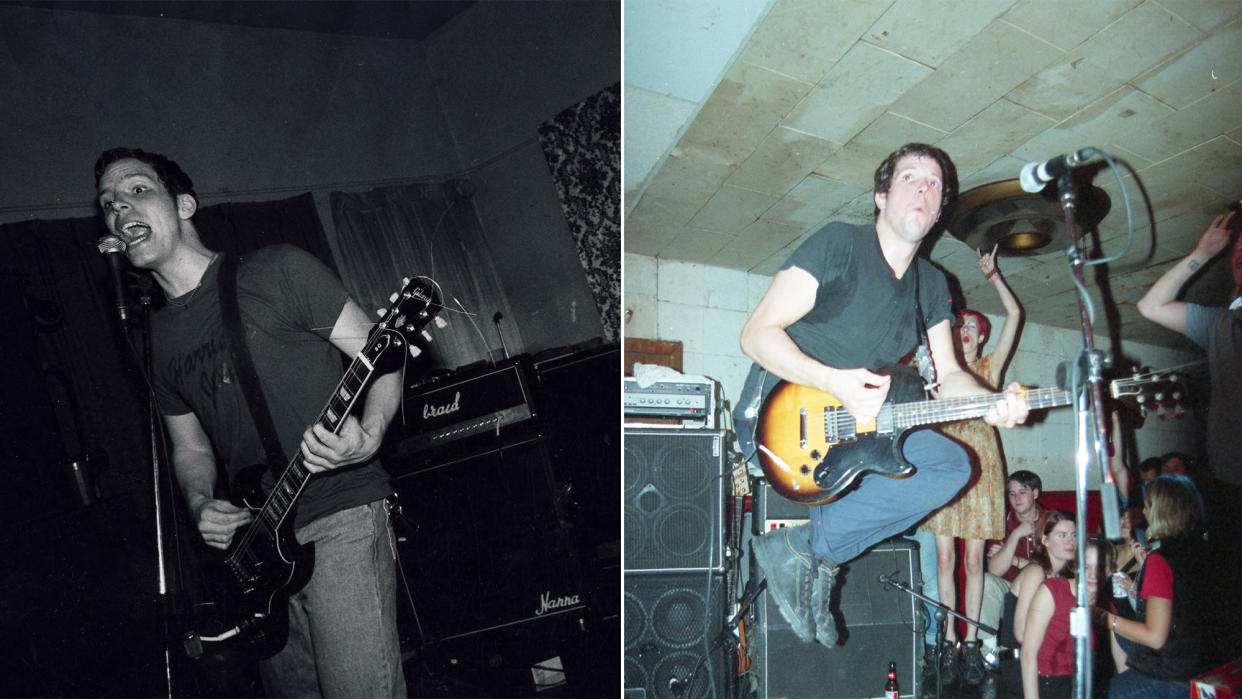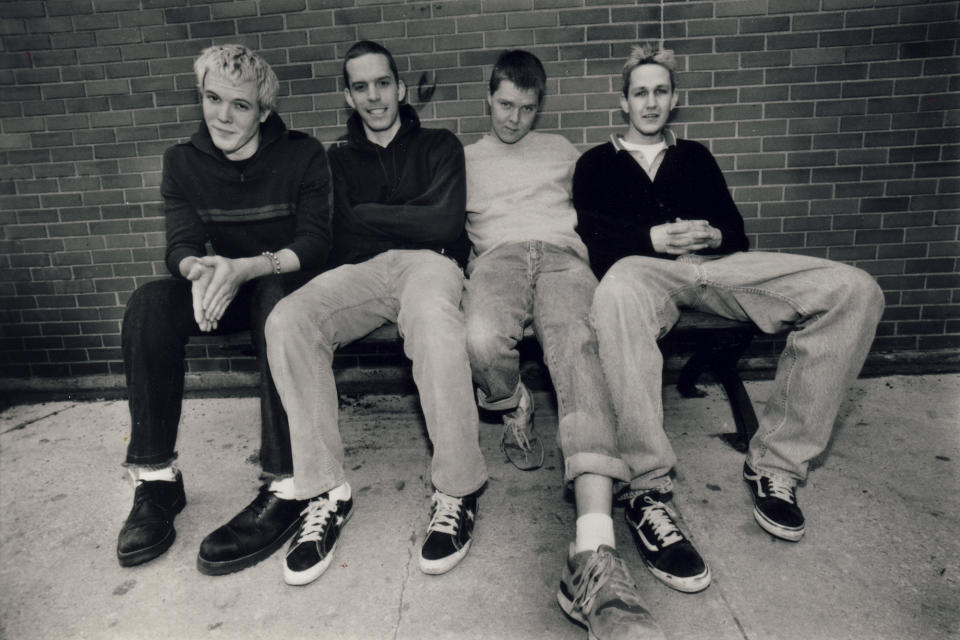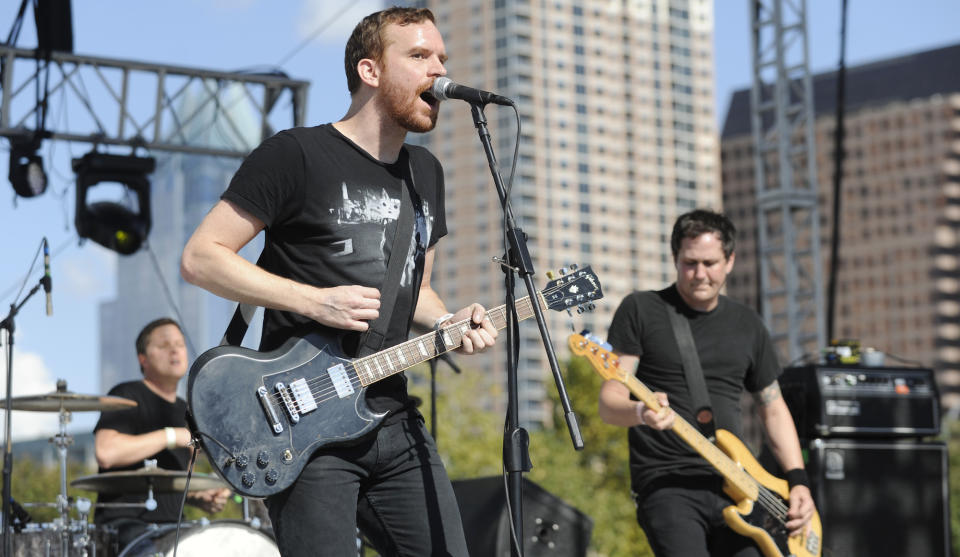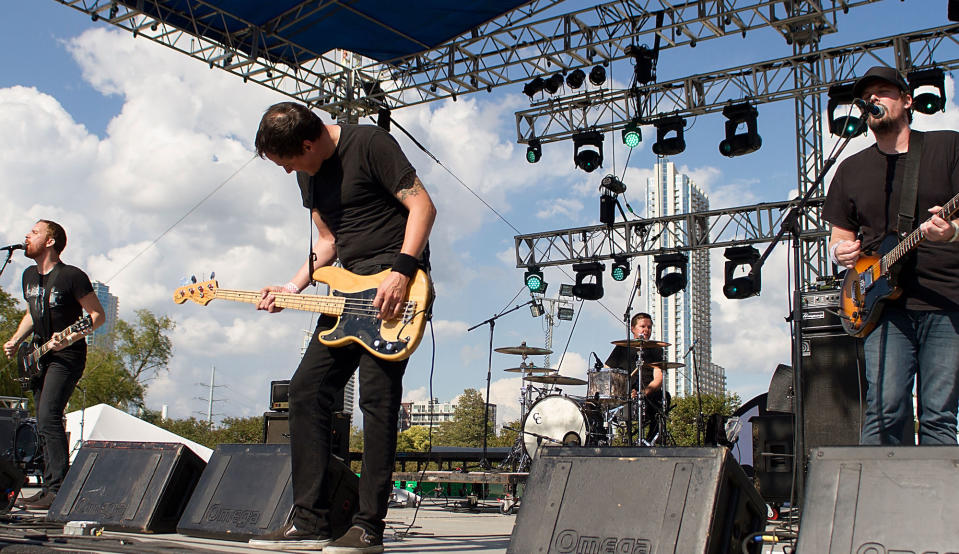Braid's Bob Nanna and Chris Broach discuss how octave chords and unconventional rhythms helped shape their Midwest emo landmark, Frame & Canvas

- Oops!Something went wrong.Please try again later.
- Oops!Something went wrong.Please try again later.
- Oops!Something went wrong.Please try again later.
- Oops!Something went wrong.Please try again later.
More than simple emo nostalgia, the looming hum of a bulldozer engine was arguably the biggest influence on the new, 25th anniversary remix and remaster of Braid’s influential 1998 LP, Frame & Canvas.
Back in the fall of 2021, album producer J. Robbins received a call from Inner Ear Studios owner Don Zientara with a request to drop by the Arlington, Virginia building where Frame & Canvas – not to mention releases from Fugazi, Foo Fighters, and countless others – had been tracked, to rummage around for mementos before the property was leveled in a few weeks’ time.
While there, Robbins discovered a few long-forgotten two-inch reels from the Frame & Canvas sessions, which got the producer thinking about revamping the original recordings. When he reached out to the Champaign, Illinois-formed quartet about buffing up the tunes – which were rush-recorded and mixed across five days at the end of 1997 – they happily co-signed the project.
“Luckily, Inner Ear kept all of their tapes safe,” guitarist/vocalist Bob Nanna explains, adding, “Thank God, because that’s not the case with the earlier Braid records. Those were literally taped over – those won’t ever get remixed, sadly.”
Co-vocalist/guitarist Chris Broach confirms that he’d previously reached out to producer Andrew Beddini to track down the masters for some early Braid 7-inches and their 1995 debut full-length, Frankie Welfare Boy Age Five, but he was told those particular ADATs were either sold off or wiped clean for other recording projects.
“They were just [converted] VHS tapes," Broach recalls. "I wish we had just kept them, but we weren’t thinking that far ahead.”
Though Frame & Canvas was Braid’s third full-length album overall, it was also Nanna, Broach, and bassist Todd Bell’s first full-length alongside drummer Damon Atkinson. Songs like Ariel still possessed the manic, emo-core pacing of earlier Braid efforts, but the percussionist also anchored the band into its deepest grooves yet on tracks like A Dozen Roses.
For their part, Nanna and Broach soared out octave harmonies that bore the influence of Fugazi, but Frame & Canvas also had them mashing out quick-clip arpeggios (Breathe In), and melodic, fretboard-vaulting lead lines like veritable Midwestern Johnny Marrs (First Day Back).
By the time Braid made Frame & Canvas, the group were studio vets, with a pair of albums and dozens of songs earmarked for various compilations and split-single releases under their belt already. Despite the hurried conditions of the Frame & Canvas sessions, Braid were well-oiled and ready to roll.
“We literally toured [on our way down] to the studio,” Nanna confirms. “We played those songs a lot."
To celebrate the reissue, Braid have announced a round of reunion dates that start up in July. Ahead of the summer tour, they’re stoked to deliver a familiar, yet fresh Frame & Canvas to their faithful.
“Sonically, there is a lot more depth,” Broach notes of the update. “I feel like the bass is heavier, and more rounded-out; the guitars are clearer. It’s got excellent production. Did it need a [remix]? No. But is it awesome? Yes!”
Speaking with Guitar World, Nanna and Broach further detail the remix project, how their guitar playing stacks up to the contemporary virtuosos inspired by Frame & Canvas, and what the future holds for Braid.

Since this is a fully remixed-and-remastered version of Frame & Canvas, what were you looking to brighten up or sweeten?
Broach: "Damon was sort of doing the back-and-forth, as the management for our side of it, but I was like, 'Let’s ask J. if he wants to take a pass at it, and then let’s give him notes.' I wanted J. to hear it with fresh ears and mix it without us saying, 'You know, I really wish my bass was louder' – obviously everyone’s going to say that piece. And, actually, the mixes [are] clearer."
Nanna: "It’s been said many times, the recording and mixing process of Frame & Canvas, when we’d originally done it in late ’97, was so fast. And it was in the first half dozen or so records that J. had actually worked on. Since then, he’s become an absolute superstar genius engineer. I think he always wanted to go back and tweak some things. But, yeah, we didn’t really give him any explicit notes."
Broach: "I think we said, 'Make it like a mix you’d make today,' but we had some caveats, too. He asked, 'How far down the road do you want me to go? Do you want me to auto-tune things?' – things he might do now that weren’t available to us then. But we were like, '…don’t go too crazy.'" [laughs]
So, nothing’s been auto-tuned?
Broach: "No, and we didn’t go back and redo parts."
Were there any overdubs or leftover parts you’d tracked back in ’97 that were pulled back from the original mix?
Broach: "I don’t know if it’s a secret, but we had a false start on one song, which was funny. I think Bob was in [the vocal booth afterwards] and he went to start singing [along to the false start], right Bob?"
Nanna: "Yeah, that was Collect to Clark Kent. I’d completely forgotten about that. J. had put it in our first set of mixes [for the reissue], and [we were like,] 'Well, that’s funny, but let’s not put that on there.'
"I do remember hearing some percussion that had either been buried or hadn’t made it into the [original] mix. And some of our vocals had been brightened up or raised in the mix, so much so that I thought they were different takes. But upon further contemplation, no. That was [on] Never Will Come for Us. I was like, 'Woah…that doesn’t sound familiar at all.'”
Braid were an impressively prolific band in the ‘90s – tons of 7-inches, split releases, and comp songs, on top of putting out three full-lengths in three years. From the outside, it feels like not a lick was wasted. Were there any extra other songs left over from these sessions?
Nanna: "No. We literally had five days to record and mix it. Not only were there no extra songs recorded, I’m pretty sure we didn’t even have any extra songs."
Broach: "The fact that we were very prolific – I think we just didn’t say no [to opportunities]. Like, 'You want to do a 7-inch?' 'Yeah, we’ve got some songs!' I think we documented everything, pretty much."
Nanna: "On the first record [1995's Frankie Welfare Boy Age Five], we even had a liner note that said 'we want to be on your comp!' It was sort of a funny thing, but people would contact us. Unless there was some sort of scheduling issue, we pretty much always said yes. It was frustrating for us, at times, to do so much, but also, it made us better in the studio. A little more disciplined. And it gave us some forced experience. We loved doing it, so it wasn’t a total chore."
Broach: "Back then, too, being on a comp was another way to get our name out there. If it was a comp coming out of Richmond, Virginia, or Gainesville, Florida – like the No Idea comp, [1997’s Bread the Edible Napkin] – we knew we’d be on a comp with a ton of bands that were also touring. And the next time we’d come through Gainesville, people who hadn’t bought our record might have bought this zine’s comp, and at least know us [through that].
"It wasn’t like we could just send a playlist to somebody, or a song on Spotify. It was free promotion – we looked at it that way."
The guitar work on Frame & Canvas pieces like A Dozen Roses was rich and harmonious, though it’s presented more subtly than earlier, more outwardly intricate Braid songs like I’m Afraid of Everything, or That Car Came Out of Nowhere. Where were you at with song construction at this point in Braid’s career?
Broach: A Dozen Roses might’ve been one that we started jamming in [Bob’s] parents’ basement with Damon. I remember Damon playing that hip-hop drum beat, and I was like, 'Wow, I'm so glad Damon joined this band.'"
Nanna: "We had a very linear way of building a song. I think with [Frame & Canvas opener] The New Nathan Detroits, we just said, 'Damon, come up with a really cool drum beat, and we’ll go from there.' We did that all the time."

Neither of you are lead players in that traditional sense, but there is this frenetic, zig-zagging nature between your respective parts. No one is really commanding lead the entire time. How did you go about developing, and harnessing, that kineticism?
Broach: "I don’t think Bob and I sat down and thought, 'I’m going to do a lead here while you do this.' We were finding things that fit with each other. Half the time, I didn’t even look at what he was playing, I just listened to what it was sounding like."
Nanna: "We were massively influenced by Fugazi, [and] each person having their place – whether it’s taking a lead vocal, sharing vocals, or sharing little guitar licks. The whole band grew up adoring Fugazi – I mean, we recorded this at Inner Ear, right? By extension, there was also a band called Gauge from the Chicago suburbs that were like our local Fugazi, that we were able to go see – and not completely rip off, but definitely be inspired by."
Broach: "They had a similar vibe. They did math-y punk, with these great starts and stops. I don’t know why [our playing] was so frenetic. I think all of us were trying to keep up with each other. If I was going to sing something, I might just naturally play something a little easier. If it was Bob singing, he might do the same. I won’t say that it was always easy to sing and play the guitar parts that we wrote, though."
Nanna: "One last thing I’ll say is that I think our original drummer, Roy Ewing, probably had a lot to do with that freneticism, because he had such a unique, out-of-the-ordinary style of playing – these off-kilter, syncopated lines. I think it was impossible for him to play a straight beat, which was amazing. That definitely set us on a particular path."
Getting back to what Chris was saying about singing and playing at the same time, and how that affected Frame & Canvas, specifically – the non-stop arpeggio that goes through the verses of Breathe In – which Chris sings – is a Bob guitar line, then?
Broach: "Yeah, that’s not me. I’m playing one note for most of the song [laughs]. One chord through the verse, at least. An octave."
Octave harmonies seemed to be a good go-to guitar language for you two, especially on this record.
Nanna: "Especially when Braid started, I was pretty much a beginner at guitar. [After] learning how to do those octave chords, my mind was blown. That opened up a whole melodic world to me. Also, it made me feel confident enough to try and do weirder things [from there], and not follow any particular script. With a lot of the bands that we like – like Fugazi – the octave chords were just soaring. They’re easy to sing over, too."
There’s also some guitar work across Braid’s music that doesn’t necessarily speak to the punk and hardcore experience. Did any non-hardcore influences impact your playing?
Broach: "Probably in an indirect way. I grew up playing in the [school] band – I played clarinet. I remember in high school I had a jazz band teacher who I was learning music theory from. He wanted me to join and play trumpet. And I was pretty good friends with this guy Victor [Villarreal]. Vic played in [legendary Chicago emo band] Cap’n Jazz.
"I went to high school with him – I used to skateboard with him. He really had a non-punk way of playing guitar. We’d all go over to a friend’s house in the neighborhood, and he’d play Greensleeves – he’d do these great arpeggiated things, which definitely influenced some of those trills that we tried to do [in Braid]."
Nanna: "Totally Vic, for sure. I would also add Kevin Frank from Gauge. He’s the person that influenced the slide [motifs] we’d use. They’re all over Gauge songs, him sliding notes up and down the neck. It sounded so fun, and playful. That was the coolest thing, to me. That definitely influenced me."
Broach: "It was a way to make a guitar [sound like] a laser beam, you know? It’s like being a boy again, playing with lasers. Just fun to do."

Are you at all familiar with the younger virtuoso players who reference Victor Villarreal's playing, or your own? Yvette Young from Covet, for instance, has specifically referenced Braid as an influence on her playing.
Nanna: "That’s cool! I’m upset that I missed them [Covet], because they were on tour with one of my favorite bands, the Velvet Teen. They played in the suburbs, but I wasn’t able to make it.
"Matt Frank is another amazing virtuoso that worships Vic, and was influenced by Braid as well. He’s in the band Their / They’re / There, and he was in Lifted Bells with me as well. I watch him play guitar and I’m like, 'There’s no fucking way I could do any of that.' [laughs] He incorporates tapping, different tunings and capos. That’s incredible, but [with] my mind, it just does not compute."
Broach: "I’ll echo that. I wouldn’t be able to keep up. With the tapping, it’s like they took what metal guitarists of our day used to do and combined it with what we were doing, punk-style. They can actually play guitar! Bob and I started by playing three-chord punk."
Nanna: "Power chords and octaves."
You spoke earlier on the evolution of Braid in terms of feel and songwriting, but did the gear list change much for you over the years?
Broach: "The only reason that my guitar changed through Braid was because my main guitar got stolen – at the same time as one of Bob’s – from a show at the Fireside Bowl [in Chicago]. I was playing an old Gibson Sonex-180, and Bob was playing an old Peavey."
Nanna: "Just this thing that I got for free."
Broach: "I bought that Sonex-180 for 300 bucks off this old metal guitarist that I knew in high school. I’ve been playing a Gibson L6S since then – I’m a big Gibson guy. Amp-wise, I had some weird head – a Yamaha of some kind – with a cabinet that had these awful caster wheels on it. That was the first couple of years, until we eventually bought Marshall heads. I still play the Marshall I bought in the Braid days, but I play Orange now, too."
Nanna: "When my guitar got stolen, I [bought] a Gibson SG, and that’s what I’ve been playing ever since. We get dialed in, and then we don’t mess with it too much."
Broach: "We weren’t really a pedal band. We might’ve had a boost here or there, or maybe something to loop something very simple, but we never used delays or reverb."
It’s been almost 10 years since the release of Braid’s last album, No Coast. Are you feeling the itch to write again, or are you content to just celebrate Frame & Canvas?
Nanna: "Two days ago, I went and saw this band Soulside – an old, seminal DC hardcore band – and J. Robbins actually opened the show, with his full band. He was doing all-new songs from his [next] solo record. I was like, 'You know, maybe Chris and I should just start writing some new songs.' This isn’t like, 'You heard it here first,' but I’m not opposed to it. Obviously, we’re going to be playing [Frame & Canvas] on this tour, so that’s the focus."
Broach: "I’m surprised to hear Bob say, 'Yeah, I’ve been thinking about it,' because he [usually] keeps that close to the chest. I’ll tell you this, I’m not opposed to it either. I’m super stoked to get out and play this stuff again, but I’ve hinted at this to the guys – if we end up writing something, I’ve got mics and a studio set up [at home] and we could demo stuff. That’s what I’ll say."
Braid's Frame & Canvas 25th Anniversary Edition is set for an April 7 release via Polyvinyl Records.

